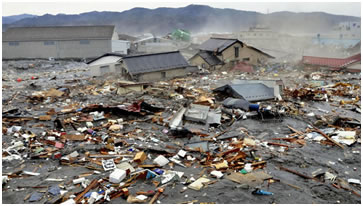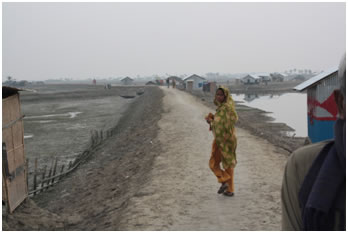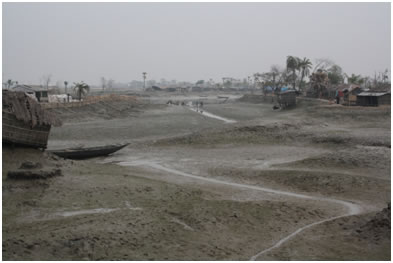Topic 3: The disaster cycle
Stakeholder groups in emergency response and recovery

Japan earthquake 2011
Source: http://www.foun.org.au/files/164701_164800/164785/japan-earthquake-tsunami.jpg
The Disaster Risk Management Cycle (Figure 3.1) suggests that large numbers of different stakeholders can be involved in both the Emergency Response and Recovery Stages of a disaster. Traditionally, the following stakeholder groups are involved in any disaster:
- The affected community themselves
- Host government at all levels, from local, and then up (depending on the magnitude of disaster) through district/state/province, to national level
- A variety of government departments at all level of governance, with particular departments allocated key roles. For example, within the Government of Bangladesh, responsibility for their Comprehensive Disaster Management Programme (see http://www.cdmp.org.bd) is handled by the Ministry of Food and Disaster Management.
- Emergency services (including police), supported by the armed forces where necessary
- The Red Cross/Crescent, supported by local community groups and faith institutions (e.g. churches/mosques/temples) and faith-based organisations
- Non-government organisations, both national and international
- The private and business sectors, including specialised Disaster Risk Management consultancies
- Volunteers and volunteer groups
- The media
- Hazard-related research institutes
- Financial donor organisations, both national, international (e.g. AusAID) and multinational (e.g. Asian Development Bank; the World Bank; the European Commission). Increasingly this list includes organisations from some Arabian Gulf States, parts of Asia and central Europe, South Africa, and a number of Latin American countries. A small number of mostly Western governments provide the majority of international humanitarian assistance, these countries being represented on the Development Assistance Committee of the Organisation for Economic Cooperation & Development (OECD).
- International agencies, such as the International Federation of Red Cross and Red Crescent Societies (IFRC), and UN operational agencies
- Peace-keeping agencies, whether UN or non-UN in composition

Bangladesh a few years on from Cyclone Aila Bangladesh a few years on from Cyclone Aila. New housing is visible in the distance. International aid organisations have agreed to not only supply the materials for housing, but to pay villagers a wage to build their own houses. Source: V. Ingham 2010 |
In recent years there have been new stakeholder groups, such as the Provincial Reconstruction teams (PRTs) in Afghanistan and the Private Service Providers (PSPs) in a number of other conflict-related countries. These organisations are involved in complex emergencies. A further stakeholder group involved particularly in conflict-related situations is what is called the Armed Non State Actors. For more information see Max Glaser’s Humanitarian engagement with non-state armed actors. According to Glaser, non-state armed actors are people who are armed and use force to achieve their objectives, and they are not under state control. The issue and challenge of coordination is normally handled by the host government. In major disasters however, there may be a role for additional coordination assistance to be offered by the international community, usually through specialised UN agencies such as the United Nations Office for the Coordination of Humanitarian affairs (UNOCHA http://ochaonline.un.org). For example, for the three months of Jan-March 2005, following the Indian Ocean tsunami, UNOCHA and other international players greatly augmented the coordination carried out by the Government of Indonesia. Following the 2004 Indian Ocean Tsunami, and subsequent major evaluations of this (see http://www.alnap.org/initiatives/tec.aspx ), the international community increasingly made moves to improve coordination, particularly during the Emergency Response and Early Recovery Stages, by encouraging the development of what is called ‘Cluster Approach’. |
In practice this means the drawing together and meeting of different sectors, both as a means of strategic planning and information sharing. The twelve most commonly formed clusters are:
|

Total devastation of a village by Cyclone Aila Source: V. Ingham 2010 |
Regarding Clusters, the Haiti Real Time Evaluation report indicated that it would be useful to have smaller ‘Strategic Advisory Groups’ to look at overall strategic development, with the larger numbers in the main clusters being there for information sharing. The Real Time Evaluation report also highlighted the importance of effective clusters being developed in the countryside and not only in the capital city. |
 |
|
Read the Haiti Real Time Evaluation Report. |
|
 |
|
Read the Victorian Bushfire Royal Commission’s Final Report Recommendations |
|
